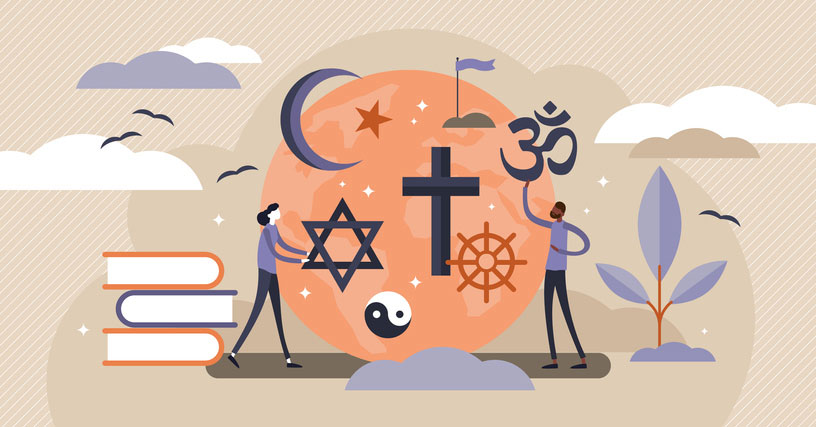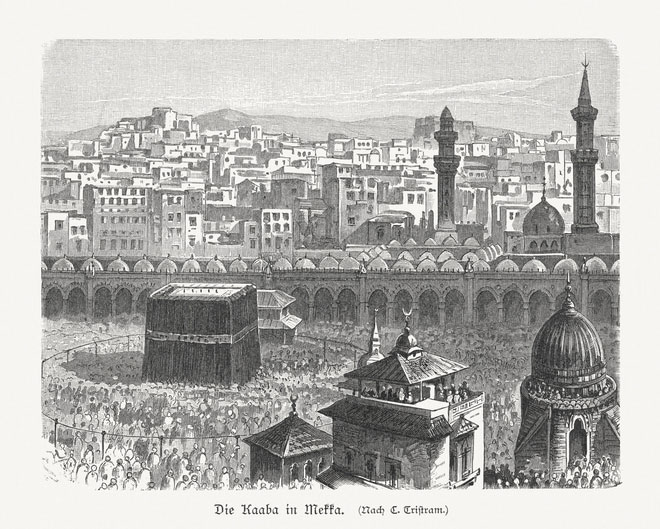

Religion is a personal, cultural, and societal way of explaining the world around us. It’s a topic that fits in well with a liberal arts education because it can be defined in many different ways:
- Culturally religion is defined as a shared philosophical belief by a social group that provides guidance for how to live as a society.
- Psychologically religion is defined as a way for an individual to make sense of their surroundings, answer important questions, and is a guide for how to behave ethically.
- Artistically religion is defined as a source of inspiration, serving as a symbol of beauty, purity, salvation, and wisdom for sculptors, painters, architects, musical composers, writers, and dancers throughout the world.
- Scientifically religion is defined as a way to answer unknown questions about the world and explain how it works.
- Gastronomically religion can be defined by its guidance on dietary restrictions, fasts, and celebratory feasts. Food is a central part to human culture and religion.
Since the dawn of humans on earth we’ve used religion to understand our reality. To hunter gatherers religion involved animism, polytheism, and attempts to cure sickness.
Monotheism developed around the time of the first ancient civilizations, where rule was by a king who was seen as being endowed with his authority by God. In these times people used religion as a means for having a good harvest, avoiding sickness, and being successful in battle.
Today in the technological age when science can provide answers to many of humankind’s most pressing questions, religion still plays as a role that many cherish as a source of inspiration, hope, and ethics. It also provides a shared set of cultural guidelines and values.
The World’s Major Religions Through the Lens of the Liberal Arts
 Currently the population of the world is approximately 7.9 billion people. Of those:
Currently the population of the world is approximately 7.9 billion people. Of those:
- About one-third (32%) or 2.5 billion are Christian; this includes 1.3 billion Catholics, 800 million Protestants, and 220 million Eastern Orthodox believers
- About one-quarter (24%) or 1.9 billion are Muslims; this includes approximately 1.7 billion Sunni Muslims, and approximately 285 million Shia Muslims
- About 1.2 billion (15%) are Hindus
- About 520 million (7%) are Buddhists
- About 394 million (5%) practice Chinese traditional religions, a combination of Taoism, Buddhism, and Confucianism
- About 100 million (1%) practice traditional African religions that are highly diverse and combine elements of animism, polytheism, and pantheism
- About 1.2 billion people (15%) are non-religious or secular
Every one of these religions, as well as those not listed, have a long history and rich tradition of art, music, philosophy, and culture that can be best understood within the context of a broad liberal arts education.
History and the Liberal Arts Provide Details of Religious Persecutions
Just as religion has been endemic to humankind throughout history, so unfortunately has religious persecution. Times of religious persecution are usually well-chronicled among the believers who were wronged, with long memories of unresolved injustices lasting through the present.
History plays an important role in understanding past instances of religious persecutions and ensuring they don’t happen again. There are also strong cultural implications surrounding instances of religious persecutions; sometimes they’re even defining moments in a religion.
Religious cultural support helps to reign in feelings and emotions that might otherwise boil over. Because religion and culture are so intertwined, sometimes it’s difficult to separate the persecution of a religious group from the persecution of a cultural or ethnic group.
These are some historic and recent events of religious persecution that are best analyzed in the framework of a liberal arts education:
- Throughout most of its existence the Roman Empire persecuted Christians. They were executed en masse, fed to the lions in the Coliseum, tortured, and blamed for events like the Great Fire of Rome in 64 AD.
- In 1492 present-day Spain expelled all non-Christian Jews and Muslims during the Reconquista, which was followed by the Spanish Inquisition. Whereas Christians and Jews were allowed to practice their religions in Muslim Spain, the same was not true by the time Christian rulers controlled the territory. Some 200,000 Jews were expelled during this time.
- During World War Two the Nazis came to power in Germany and attempted to eliminate the Jewish population of Europe. Over the course of the war two-thirds of Europe’s Jewish population –6,000,000 people– were killed.
- Today in Buddhist-majority Myanmar some 25,000 Muslims have been killed and over 700,000 have fled the country as a result of cultural-political-religious violence.
Understanding religious persecutions in their full context requires a liberal arts framework, and serves as an insurance policy that history will not repeat itself.
So-Called Religious Wars Gain Needed Depth with the Liberal Arts
The trope of the clash of civilizations and religious strife is popular, but it’s not necessarily accurate, as the liberal arts demonstrate with a full-spectrum approach.
Religion is often blamed for conflict when the underlying causes are just as much, if not more so, economic:
- The 30 Years War in Central Europe between 1618 to 1648 is often framed as a showdown between Catholicism and Protestantism, however it has just as much to do with imperial power.
- China often frames the conflict in Tibet and Xinjiang as a civilizing state improving religious animistic and Islamic backwaters, when these conflicts with Tibetans and Uigers have more to do with the Chinese Communist Party’s drive for regional hegemony
- The conflict between nuclear-armed India and Pakistan over Kashmir is often framed as being Muslim versus Hindu, but it’s actually much more about regional powers exerting influence.
- The conflict between Israeli Jews and Muslim Palestinians is often invoked as the ultimate symbol of a modern religious conflict, however it has just as much to do with tribalism and regional politics as it has to do with religion.
- America’s War on Terror represents the archetype of the clash of civilizations trope; however, it can just as accurately be viewed in the context of neo-imperialism and competition for an economic and political upper hand.




